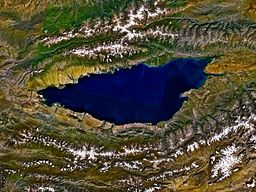
Back بحيرة إيسيك كول Arabic بحيره ايسيك كول ARZ Llagu Issyk-Kul AST İssık-Kul Azerbaijani ایسیقگؤل AZB Эҫек-Күл Bashkir Issyk-Kul BCL Ісык-Куль Byelorussian Ісык-Куль BE-X-OLD Исък Кул Bulgarian
| Isyk-Kul | |
|---|---|
 Issyk-Kul from space, September 1992 | |
| Coordinates | 42°25′N 77°15′E / 42.417°N 77.250°E |
| Lake type | Ancient lake, Endorheic Mountain lake Monomictic |
| Primary inflows | Glaciers |
| Primary outflows | Evaporation |
| Catchment area | 15,844 square kilometres (6,117 sq mi) |
| Basin countries | Kyrgyzstan |
| Max. length | 178 kilometres (111 mi)[1] |
| Max. width | 60.1 kilometres (37.3 mi)[1] |
| Surface area | 6,236 square kilometres (2,408 sq mi)[1] |
| Average depth | 278.4 metres (913 ft)[1] |
| Max. depth | 668 metres (2,192 ft)[1][2] |
| Water volume | 1,736 cubic kilometres (416 cu mi)[3][2] |
| Residence time | ~330 years[2] |
| Salinity | 6g/L[1][2] |
| Shore length1 | 669 kilometres (416 mi)[1] |
| Surface elevation | 1,607 metres (5,272 ft)[1] |
| Settlements | Balykchy, Cholpon-Ata, Karakol |
| Official name | The Issyk-kul State Nature Reserve with the Issyk-kul Lake |
| Designated | 12 November 2002 |
| Reference no. | 1231[4] |
| 1 Shore length is not a well-defined measure. | |
Issyk-Kul (Russian: Иссык-Куль) or Ysyk-Köl (Kyrgyz: Ысык-Көл, IPA: [ɯsɯ́q kʰɵ́l]; lit. 'Warm Lake') is an endorheic saline lake in the western Tianshan Mountains in eastern Kyrgyzstan, just south of a dividing range separating Kyrgyzstan from Kazakhstan. It is the eighth-deepest lake in the world, the eleventh-largest lake in the world by volume (though not in surface area), the deepest lake whose deepest point is above sea level (939 meters or 3,080 feet), and the third-largest saline lake. Although it is located at a lofty elevation of 1,607 metres (5,272 ft) and subject to severe cold during winter, it rarely freezes over due to high salinity, hence its name, which in the Kyrgyz language means "warm lake".[5][6]
The lake is a Ramsar site of globally significant biodiversity[7] and forms part of the Issyk-Kul Biosphere Reserve.
- ^ a b c d e f g h Savvaitova, K.; Petr, T. (December 1992), "Lake Issyk-Kul, Kirgizia", International Journal of Salt Lake Research, 1 (2): 21–46, doi:10.1007/BF02904361
- ^ a b c d Hofer, Markus; Peeters, Frank; Aeschbach-Hertig, Werner; Brennwald, Matthias; Holocher, Johannes; Livingstone, David M.; Romanovski, Vladimir; Kipfer, Rolf (11 July 2002), "Rapid deep-water renewal in Lake Issyk-Kul (Kyrgyzstan) indicated by transient tracers", Limnology and Oceanography, 4 (47): 1210–1216, doi:10.4319/lo.2002.47.4.1210
- ^ Kodayev, G.V. (1973), "Морфометрия озера Иссык-Куль" [Morphometry of Lake Issyk-Kul], News of the All-Union Geographic Society (Izvestiya VGO) (in Russian)
- ^ "The Issyk-kul State Nature Reserve with the Issyk-kul Lake". Ramsar Sites Information Service. Retrieved 25 April 2018.
- ^ Nihoul, Jacques C.J.; Zavialov, Peter O.; Micklin, Philip P. (2012). Dying and Dead Seas Climatic Versus Anthropic Causes. Springer Science+Business Media. p. 21. ISBN 9789400709676. Retrieved 4 December 2015.
- ^ "Extreme cold weather freezes Issyk-Kul lake | Copernicus". www.copernicus.eu. Retrieved 2023-06-10.
- ^ Ramsar Site RDB Code 2KG001




